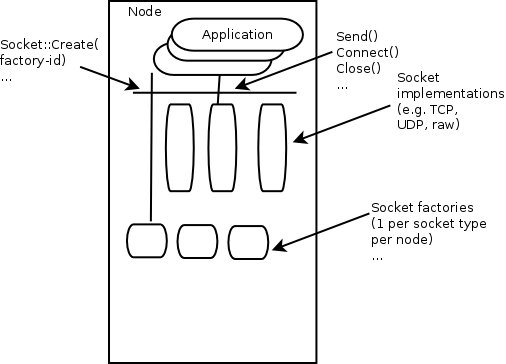
|
A Discrete-Event Network Simulator
|
Models |
The sockets API is a long-standing API used by user-space applications to access network services in the kernel. A socket is an abstraction, like a Unix file handle, that allows applications to connect to other Internet hosts and exchange reliable byte streams and unreliable datagrams, among other services.
ns-3 provides two types of sockets APIs, and it is important to understand the differences between them. The first is a native ns-3 API, while the second uses the services of the native API to provide a POSIX-like API as part of an overall application process. Both APIs strive to be close to the typical sockets API that application writers on Unix systems are accustomed to, but the POSIX variant is much closer to a real system’s sockets API.
The native sockets API for ns-3 provides an interface to various types of transport protocols (TCP, UDP) as well as to packet sockets and, in the future, Netlink-like sockets. However, users are cautioned to understand that the semantics are not the exact same as one finds in a real system (for an API which is very much aligned to real systems, see the next section).
ns3::Socket is defined in src/network/model/socket.h. Readers will note that many public member functions are aligned with real sockets function calls, and all other things being equal, we have tried to align with a Posix sockets API. However, note that:

Implementation overview of native sockets API
An application that wants to use sockets must first create one. On real systems using a C-based API, this is accomplished by calling socket()
int socket(int domain, int type, int protocol);
which creates a socket in the system and returns an integer descriptor.
In ns-3, we have no equivalent of a system call at the lower layers, so we adopt the following model. There are certain factory objects that can create sockets. Each factory is capable of creating one type of socket, and if sockets of a particular type are able to be created on a given node, then a factory that can create such sockets must be aggregated to the Node:
static Ptr<Socket> CreateSocket (Ptr<Node> node, TypeId tid);
Examples of TypeIds to pass to this method are ns3::TcpSocketFactory, ns3::PacketSocketFactory, and ns3::UdpSocketFactory.
This method returns a smart pointer to a Socket object. Here is an example:
Ptr<Node> n0;
// Do some stuff to build up the Node's internet stack
Ptr<Socket> localSocket =
Socket::CreateSocket (n0, TcpSocketFactory::GetTypeId ());
In some ns-3 code, sockets will not be explicitly created by user’s main programs, if an ns-3 application does it. For instance, for ns3::OnOffApplication, the function ns3::OnOffApplication::StartApplication() performs the socket creation, and the application holds the socket pointer.
Below is a typical sequence of socket calls for a TCP client in a real implementation:
There are analogs to all of these calls in ns-3, but we will focus on two aspects here. First, most usage of sockets in real systems requires a way to manage I/O between the application and kernel. These models include blocking sockets, signal-based I/O, and non-blocking sockets with polling. In ns-3, we make use of the callback mechanisms to support a fourth mode, which is analogous to POSIX asynchronous I/O.
In this model, on the sending side, if the send() call were to fail because of insufficient buffers, the application suspends the sending of more data until a function registered at the ns3::Socket::SetSendCallback() callback is invoked. An application can also ask the socket how much space is available by calling ns3::Socket::GetTxAvailable(). A typical sequence of events for sending data (ignoring connection setup) might be::
* ``SetSendCallback (MakeCallback(&HandleSendCallback));``
* ``Send ();``
* ``Send ();``
* ...
* Send fails because buffer is full
* wait until :cpp:func:`HandleSendCallback` is called
* :cpp:func:`HandleSendCallback` is called by socket, since space now available
* ``Send (); // Start sending again``
Similarly, on the receive side, the socket user does not block on a call to recv(). Instead, the application sets a callback with ns3::Socket::SetRecvCallback() in which the socket will notify the application when (and how much) there is data to be read, and the application then calls ns3::Socket::Recv() to read the data until no more can be read.
There are two basic variants of Send() and Recv() supported:
virtual int Send (Ptr<Packet> p) = 0;
int Send (const uint8_t* buf, uint32_t size);
Ptr<Packet> Recv (void);
int Recv (uint8_t* buf, uint32_t size);
The non-Packet variants are provided for legacy API reasons. When calling the raw buffer variant of ns3::Socket::Send(), the buffer is immediately written into a Packet and the packet variant is invoked.
Users may find it semantically odd to pass a Packet to a stream socket such as TCP. However, do not let the name bother you; think of ns3::Packet to be a fancy byte buffer. There are a few reasons why the Packet variants are more likely to be preferred in ns-3:
Sometimes, users want the simulator to just pretend that there is an actual data payload in the packet (e.g. to calculate transmission delay) but do not want to actually produce or consume the data. This is straightforward to support in ns-3; have applications call Create<Packet> (size); instead of Create<Packet> (buffer, size);. Similarly, passing in a zero to the pointer argument in the raw buffer variants has the same effect. Note that, if some subsequent code tries to read the Packet data buffer, the fake buffer will be converted to a real (zeroed) buffer on the spot, and the efficiency will be lost there.
to be completed
to be completed
to be completed